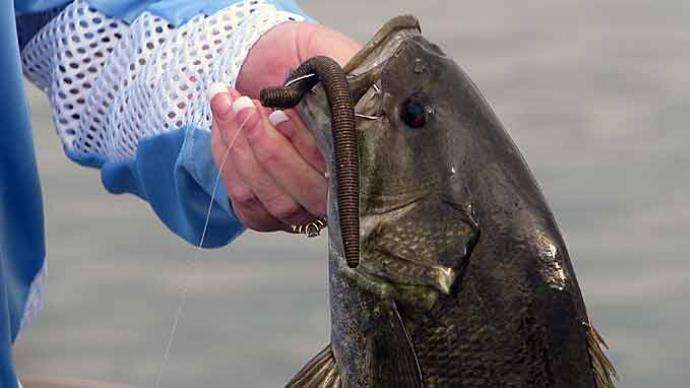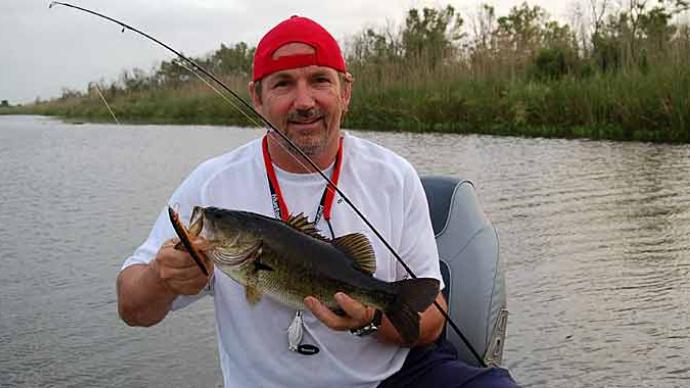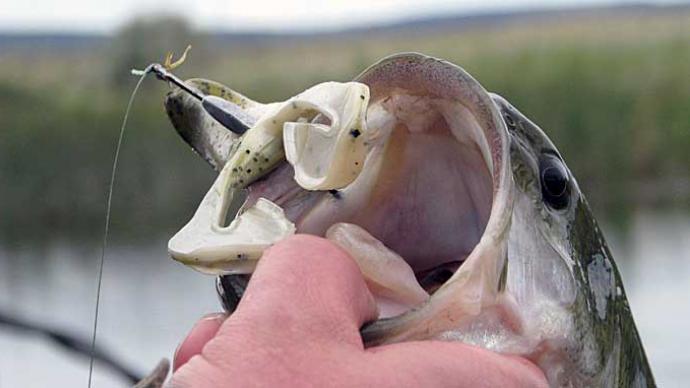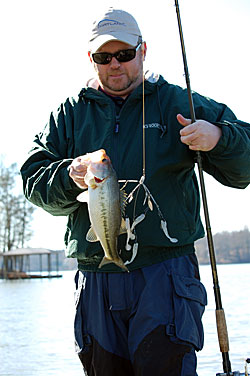
The first couple hours of a late November fishing trip had been frustrating. Despite covering a lot of water, I had yet to see a bass. My day was disappearing with the sun sinking toward the horizon. I had enough time for one more stop, so I ran to the mouth of a creek. One point, lined with riprap and a few docks, had previously given up bass. My first few casts brought back nothing. The next was a sight to see.
I cast a crankbait to shore and began a medium retrieve punctuated with pauses. As the lure neared the tip of my rod, I glanced at the water, waiting for its appearance. As it came into view, so did the school of shad — maybe 50 in total — following it. As I lifted the crankbait from the water, they continued on their way, splitting the trolling motor and disappearing into the depths on the other side.
Those shad were the only fish I saw that afternoon, but they were important ones. They revealed that baitfish were still in the main lake. That’s where I spent the next day fishing, catching enough bass to finish second in a small club tournament. And, just as they were during that afternoon of prefishing, my graphs were on full-screen mapping.
No one can deny that today’s electronics have been a boon to bass fishing. They’ve helped scores of anglers find, catch and, more importantly, return repeatedly to bass that swim in offshore schools. With screen sizes approaching the proportions of small televisions, each new model adds a new weapon to anglers’ arsenals. That includes showing the structure, cover, and bass under and out to the sides of your boat.
But electronics don’t see everything. Looking up and around, you’ll see many clues that will lead you to bass. Here are several things to keep your eyes open while on the water.
Look to the baitfish
Find the bait, and you’ll find the bass. That directive has been around for a long time and will continue to be proven true. Electronics are the best way to find bait schooled deep, but it is not the only way. Baitfish, especially shad, will school near the surface, sometimes over deep water and other times, especially during the fall, in shallow pockets and creeks.
They’ll reveal their location by the small dimples on the surface or the large splashes made by the bass chasing them.
Watch your lure as it approaches the boat. Once in a while, a bass will chase it, and suddenly stopping the lure will cause it to strike if you see it in time. Other times, baitfish — alone or in a small school — will follow it to the boat. This often occurs with lures that produce lots of sound or vibration, such as lipless crankbaits and spinnerbaits.
The best boat docks for fishing have the most baitfish. Finding them can be as easy as feeling a rock bass or bream peck at your lure. Other times you’ll need a more stealthy approach. As you are fishing along, look under pontoon boats, dock floats, and pilings. That’s where you’ll see them suspended often during the summer.
Look to the birds
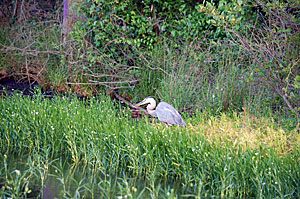
Sometimes bass location clues come from above. Certain birds associate with baitfish. The most recognizable are seagulls, which often dive-bomb schools of baitfish. On Southern impoundments, following them might lead to stripers, but you’ll often find bass.
Diving birds, such as loons, also pinpoint baitfish. They’re more likely to be found offshore. Closer to the bank, long-legged herons wade through shallow water, using their long, pointed beak to spearfish, including small bass. It’s often a good sign to see one hunting the same water you’re casting. They are fishing for survival, so they don’t spend much time in places without fish.
Look to the water
The water itself can give clues to bass location. That’s especially true where you find current, whether a river, tidal estuary, or windblown lake. Bass are ambush feeders, and they use the current to their advantage. They do that by waiting in spots sheltered from the current — eddies — and grabbing what food the water washes by them. You’ll find eddies on the downwind or down-current side of points, islands, grass beds, large rocks, and even logs. Riprap along a wing dam or surrounding a navigation channel marker can form multiple eddies, which are easy to spot. They appear as flat water spots, sometimes with a gentle upstream current, bordered by faster-moving water. Cast into the eddies and retrieve your lure along the current seams, where still and moving water meet.
The wind can show you where to fish, too. As it pushes surface water, cover and structure are revealed. It can be as apparent as waves crashing on a long, shallow point or reef or something more subtle. Look across a wind-churned lake, and you’ll see slick spots. They vary in size and shape but indicate something below. It could be a bed of aquatic grass or depth change. Either way, they are worth a few casts.
Keep your eyes open for changes in the color of the water. Bass are attracted to mud lines, where dirty water meets clearer water. They can form along a clay bank battered by waves, boat wakes, or where a creek empties into a lake or river. Bass will use the color change like any other edge. The darker water helps conceal their movements from baitfish. Work lures along the edge, such as spinnerbaits, vibrating jigs, and crankbaits.
Look to the trees
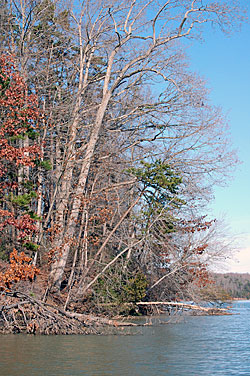
Laydowns are popular with anglers and bass. They are visible targets that offer plenty of cover. But many anglers float over their best parts by focusing on visible branches and where the main trunk meets the water. Laydowns often extend much farther underwater. As you approach one, take stock of the trees still standing on the bank. Estimate their height, and then apply that measurement horizontally onto the water. That will give you an idea of the laydown’s actual length. Sunken out of sight, the top branches are often bushier, which means more cover for bass.
Standing timber, where it’s found, diminishes as a lake age. If your lake still has some, its height can help you find structure. The largest trees are often near ditches or creek channels, where they had enough water to grow before the impoundment was built. The same holds for Southern reservoirs that have cypress trees. The tallest — and oldest — ones grow in the deepest water. Paying attention to that difference can help you eliminate unproductive stretches. For example, bass will move to those clearly marked deeper spots during a cold front.
Look to the land
The land above the waterline can tell you a lot about what is below it. Banks gently rolling into the water most often indicate extensive shallow flats, especially in the back coves and creeks. This physical feature on the main lake can reveal a long, shallow point surrounded by deep water. Bluffs and hills that quickly fall into the lake often mean deep water is close to the bank. Search out spots where the two meet and give bass a depth change.
It also is essential to examine shoreline composition. For example, if it’s a clay bank, then the lake bottom will likely be clay. The same holds when you see gravel or large rock. Finding one material can be important in certain situations, such as chunk rock in the winter or pea gravel during the spawn. But most times, you’ll want to fish the edge formed where two meet. It might be where big rocks change to gravel. In Bassmaster Elite Series angler Alton Jones’ case, sand or gravel met clay. He keyed on that subtle change in the deep-water drains he jigged and spooned to win the 2008 Bassmaster Classic on Lake Hartwell. The change was so subtle that his electronics couldn’t detect it, so he fished in front of banks where he spotted the transition.
Help your eyes
You’ll be able to pick up on many of these clues with your naked eyes, but there are ways to help them see more.
A pair of quality polarized sunglasses is the first step. Polarization stops glare from the surface, allowing you to see the water better. Like many things in life, you get what you pay for, so purchase the best pair possible. You’ll want a pair that fits snug to your face. That will keep sunlight from going behind the lenses and defeating the purpose. Lens color makes a difference. Amber or yellow lenses make things appear brighter in low-light conditions, such as in the morning or evening or on cloudy days. Grey lenses work best when the sun is brightest.
Hats, whether ball cap or Boonie, help, too. Look for brims that are a dark color on the underside. Those absorb light. Light-colored ones reflect it.
There rarely is a silver bullet when figuring out how to catch bass. Lures and spots may seem magical, but in reality, it’s a combination of factors that equally contribute to their greatness. While your electronics uncover some bass-attracting traits, your eyes can lead you to the rest.


